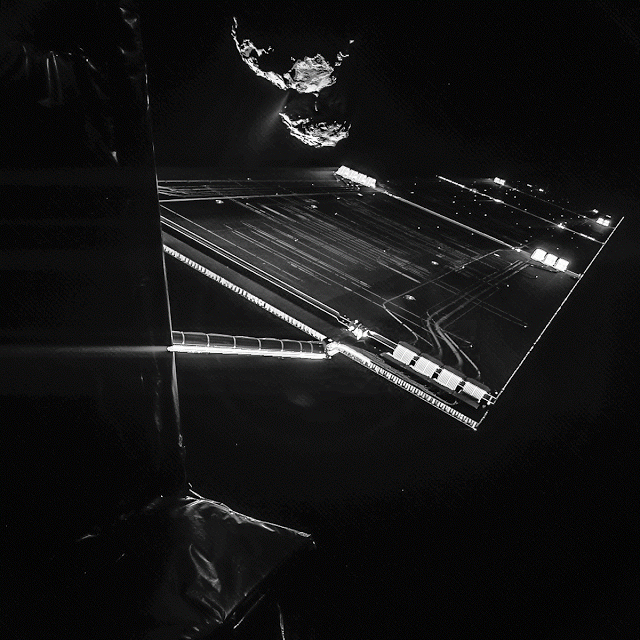Astronomy
A camera aboard ESA?s Philae lander snapped this 'Selfie' of one of the Rosetta's 52-foot-long [16-meter] solar arrays, with comet 67P/Churyumov?Gerasimenko hovering in the background some 16 kilometers away. The image was taken on Oct. 7,2014 by the Comet Infrared and Visible Analyser [CIVA].
In the image, the active ?neck? region of the comet is now clearly visible, with streams of dust and gas extending away from the comet. The primary landing site, currently known as 'Site J' can also be seen on the smaller lobe of the comet.
source:- jpl.nasa.gov
- Watch Comet Mcnaught In This June Night Sky
Do you like to watch comets on a night sky like me ? If your answer is "yes" then you can watch comet McNaught with your naked eyes.The comet's tail will look like a celestial sword angling upward to the northern sky. The comet was discovered by Robert...
- Rosetta's Closeup With Asteroid Lutetia
Asteroid Lutetia, captured by Rosetta Image: ESA ESA?s Rosetta mission successfully completed a flyby of asteroid Lutetia on July 10, capturing spectacular images of a remnant from the solar system?s creation. The spacecraft came as close as 3162 km,...
- Rosetta Have Found Oxygen On Comet 67p.
The European Space Agency's [ESA] Rosetta spacecraft has detected significant levels of molecular oxygen coming from Comet 67P/Churyumov-Gerasimenko in a discovery that has taken astronomers by surprise. Molecular oxygen has never been detected...
- An Unexpected Discovery, Comet Lovejoy Contains Alcohol And Sugar.
Comet Lovejoy lived up to its name by releasing large amounts of alcohol as well as a type of sugar into space, according to new observations by an international team of astronomers. The finding suggest that comets could have been a source of the complex...
- A Close Up Picture Of The Comet Lulin Feb 26 - 2009
The comet Lulin was jointly discovered by Asian astronomers in July of 2007. It is probably the first time the comet visits our solar system and will most likely never come back, or at least not in thousands of years. Lulin was closest to Earth on Feb...
Astronomy
The Rosetta Selfie.
 |
| The Rosetta spacecraft managed to take this picture before making history. |
In the image, the active ?neck? region of the comet is now clearly visible, with streams of dust and gas extending away from the comet. The primary landing site, currently known as 'Site J' can also be seen on the smaller lobe of the comet.
source:- jpl.nasa.gov
- Watch Comet Mcnaught In This June Night Sky
Do you like to watch comets on a night sky like me ? If your answer is "yes" then you can watch comet McNaught with your naked eyes.The comet's tail will look like a celestial sword angling upward to the northern sky. The comet was discovered by Robert...
- Rosetta's Closeup With Asteroid Lutetia
Asteroid Lutetia, captured by Rosetta Image: ESA ESA?s Rosetta mission successfully completed a flyby of asteroid Lutetia on July 10, capturing spectacular images of a remnant from the solar system?s creation. The spacecraft came as close as 3162 km,...
- Rosetta Have Found Oxygen On Comet 67p.
The European Space Agency's [ESA] Rosetta spacecraft has detected significant levels of molecular oxygen coming from Comet 67P/Churyumov-Gerasimenko in a discovery that has taken astronomers by surprise. Molecular oxygen has never been detected...
- An Unexpected Discovery, Comet Lovejoy Contains Alcohol And Sugar.
Comet Lovejoy lived up to its name by releasing large amounts of alcohol as well as a type of sugar into space, according to new observations by an international team of astronomers. The finding suggest that comets could have been a source of the complex...
- A Close Up Picture Of The Comet Lulin Feb 26 - 2009
The comet Lulin was jointly discovered by Asian astronomers in July of 2007. It is probably the first time the comet visits our solar system and will most likely never come back, or at least not in thousands of years. Lulin was closest to Earth on Feb...
